This is part 2 in the series “Siam – Discovering Karate’s Forgotten Source“. Please read part 1 if you haven’t!
“Well, it just isn’t as easy as I thought it would be!
I mean, it’s not like they advertise exactly.”
“What are you talking about?” you ask, as we’re stuffing down an ungodly lunch consisting of a banana shake, an orange shake, a tofu pad thai, a tuna steak with french fries, a couple of omelettes, some Gatorade and finally a big fruit plate.
And that was just my part.
(Oh, and it costs less than a pizza would in any western country!)
“I’m talking about the training we’re going to do!”
“What about it?” you say, with you mouth full of noodles.
“Do you seriously think this is it? That we’re just going to do regular tourist Thai Boxing and pretend it’s some kind of secret lost Karate stuff?” I say as I gobble down my third fruit shake. Mango. Oh yeah.
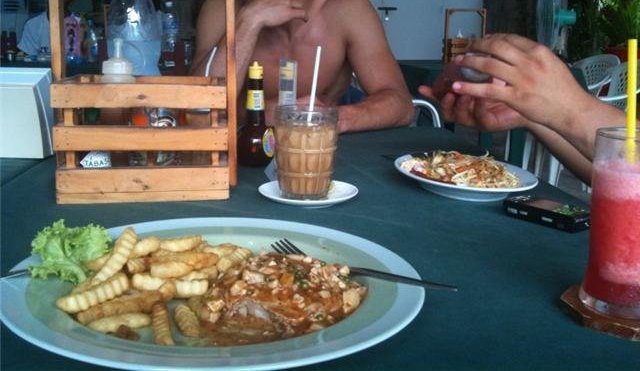
“What, there’s more? You mean there’s some semi-secret old “no holds barred” martial art that includes such things as devastating joint locks, throws, headbutts, submission reversals and takedowns that they don’t exactly advertise about, that we should investigate?”
“Wha…? How…? How did you come up with all that? Yeah, that’s exactly what I’m saying!” I say, looking positively surprised. “You know, you have your moments…”
“I know…” you say, looking rightfully satisfied.
“In fact, just like in old-style Okinawan Karate, they utilize plenty of weapons too. Swords, knives, daggers, shields, short sticks, long sticks, whatever man… and one particular weapon that we know very well from our own Okinawan kobudo practise too!”
“No way! That’s awesome! Which weapon is that?” you say, as you order another fruit plate.
“Patience, young grasshopper, you’ll see soon enough. First we’ll do the empty hand training. The locals call it Muay Boran.”
“Muay What now?” you ask.
“Muay Boran. Pull those pineapple sticks out of your ears, because I’m not going to repeat myself again. Muay Boran, which literally means “Ancient Boxing” is something of an umbrella term for unarmed martial arts in Thailand prior to the introduction of modern rules, regulations and equipment. You could call it the ancestor of modern Thai Boxing if you want to.”
“That’s great! When are we going to try it? Hey, waiter, do you know where we can try this Muay Boran thing?! HEY!”
You’re laughing and screaming, waving your hands in the air.
“Shut up! It doesn’t work like that! It’s not some commercialized strip mall storefront fitness fad! Only serious people are allowed to train it in this camp, and clearly you don’t seem like one right now!”
“Wow, slow down, I’m just kidding” you say. “Of course, let’s keep it on the low. So when are we doing this!? I can’t wait!”
“I have gotten us a special invitation for training later this afternoon. We are going to go for an introduction in the art of Muay Boran, or Nawa Awut – the old martial art of the nine limbs. Now eat up, we’ve got to rest so we’re fresh until tonight.”
You quickly sweep down your Calpis Soda.
“Yes, sir!”
[swoosh, fast forward to later that afternoon]
We are now in official Muay Boran class.
The trainer, who we never really caught the name of, is short, physically fit, and surprisingly well-articulated. His English is near perfection.
“Everybody, sit down!” he commands us.
He continues, by telling us that we will train 90 minutes, one and a half hour, and there are some ground rules that must always be followed. The main one being about discipline.
In short; always show respect, train hard, and no questions asked.
You look over at me, and I know what you’re thinking. But forget that now, we’re here to learn, not to judge.
Looking around, you notice that we are not the only foreigners here. There are some people from Switzerland here too. And some Spanish dude, whose t-shirt says “Fish of Doom”.
“Gotta get me one of those…” you think, as you’re brutally interrupted by the teacher shouting.
All of a sudden, everyone lines up.
Since its out first time, we just follow everyone else.
“Feet together” some girl whispers to you from behind, and you quickly assume the ‘heisoku dachi’ that you know so well from Karate.
The teacher says something in Thai again. Everyone switches stance, to horse stance. Or ‘kiba dachi’, as you prefer. The hands are to be held together in front of the chest, in what the teacher refers to as “prayer stance”.
This is the basic position that all moves are executed from.
And now begins the basics.
It is surprisingly similar to Karate kihon, in the way that everyone are lined up, and take turns counting to ten. The moves are changed all the time, but the basic idea is always to twist on your feet to one side and do an arm technique. We alternate between straight punches, elbow strikes, uppercuts, hooking punches and a variety of blocks.
However, there are some clear differences between these techniques and the ones you’re used to.
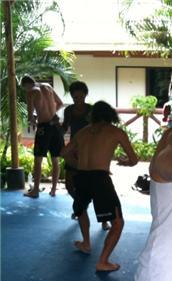
For instance, the hooks and elbow blows never come straight from the side, but always at a slight angle over the top. This, the teacher assures you, will protect your face if your opponent is to ever counter your attack. Additionally, the blocks are always done with open hands, since the purpose of them is for catching an opponent. Oh, and you’re instructed to always keep open hands when elbowing.
That was some upper body basics.
Then we do the lower body, which means all kinds of kicks, blocks with the legs and knee attacks.
However, when you do the leg block, the teacher notices something. “No, this way” he says, and separates your elbow from your knee.
“What, we’re supposed to leave a big opening in front of our ribs?” you say, looking smart.
Naturally, you’ve been brainwashed by the modern rule-bound Muay Thai and K-1 style Thai Boxing.
“Yes, this is a trap. When the opponent kicks, catch the leg, like this!” our teacher says, as he demonstrates a series of nasty elbow strikes and other ethically questionable ‘tricks’ in the air, after he caught the leg of his imaginary opponent.
“Sweet…”
Then it was time for partner drills. “Finally!” you whisper to me “These basic drills are so boring!”
I give you that distinct evil look that you know all too well.
“What do you expect? Flying 360 spinning knee strikes? We are two foreigners in our first beginners class, and we don’t even speak their language! We’re not going to see much more than this for a long time you know!”
“Yeah, whatever…”
Somehow, you knew I was going to say that.
The teacher now announces something new, and everyone pairs up.
Kumite time!
One stands in horse stance. The other stands in horse stance. One punches. The other blocks. That’s it.
Then everyone rotates, and does the same thing against a new partner. It’s actually very much like the basics we just did, but against a partner instead of thin air.
And suddenly, it’s all over.
Done.
One and a half hour is over, and it feels like we’ve done nothing! It went so fast! The teacher assures us that we did well, and that next week he would perhaps add one more partner exercise.
Immediately, the words of Itosu Anko dawned upon me:
“Karate cannot be learned quickly. Like a slow moving bull, that eventually travels a thousand miles…”
We wait around a while for everybody to leave.
Of course, we have some questions for the trainer.
When everyone has left, I finally approach him. You’re behind me.
“Hello there, yes, hi, excuse us, we have some q-q-questions” I stutter, hoping not to get my nose cracked. But it seems okay. It’s intact.
“Yes?” the techer, who we still don’t know the name of, answers kindly. He is smiling.
“We were just wondering, do you have different styles in Muay Boran? You see, we train Karate, and in Karate we have this huge problem called styles, which basically does nothing but separate people from each other and, quite frankly, causes all kinds of political and personal trouble” I tell him.
He answers that yes, they have styles.
Sort of.
There are slightly different versions of Muay Boran being practised throughout Thailand, he says, but these differences had evolved naturally from regional and geographical reasons, rather than from people changing things or making things up for the sake of creating their own fractions or “styles”.
He agreed to pose for some pictures.
“What?! Quick, get the camera! This is a once in a lifetime moment!” I scream.
You hurry to get the notebook and camera, because you know as well as me that we were about to be treated to some knowledge that few (if any?) foreigners possess. This teacher was truly a living encyclopedia of Muay Boran knowledge.
Here’s some of what he showed, and said:
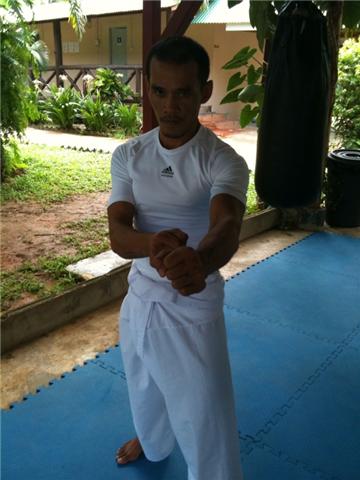
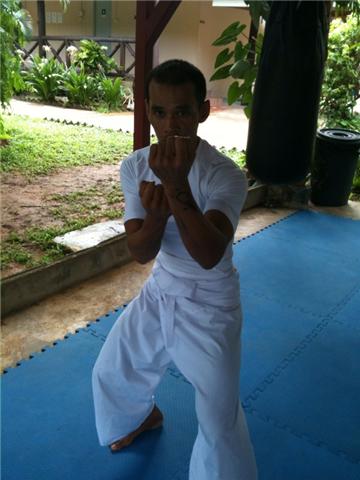

“Okay, okay, yes, yes…very interesting” you mumble, writing everything down.
I look over your shoulder, on the notes.
“No dude, that’s got to be “Muay” Lom, not “Moi” Lom. Why should it suddenly be “Moi”, when the two he showed before starts with “Muay”?!” I ask you.
“I don’t know, it sounded like that! Everything sounds the same to me, how should I know?! You do it!” you tell me, shoving the pen and paper in my chest.
“Sorry about my friend, he’s illiterate” I say to the teacher, who still seems willing to answer questions a couple of minutes more before it’s dinner time.
So, I know what you’re thinking:
Do they have any forms, or kata, in Muay Boran? Some mystical geometrical patterns that unlock all secrets of Karate – and suddenly everything makes sense?
When asked about this, he suddenly becomes a bit defensive.
Something feels wrong.
“Yes we have forms…” he hesitates a second, and then says “…but we dont like do be stuck in forms. Like the lotus flower – where the water doesn’t stop and gets stuck in the flower, it always goes around.”
“Oh, I see…” I mumble, scribbling everything down.
“Hey, isn’t that kind of like what Nakasone Genwa wrote in that old Karate book that you have?” you ask me.
“Hmm? You mean Karatedo Taikan, from 1938? What about it?” I ask you back.
You’re looking smart again.
“Well, if I remember correctly, he writes something like ‘There’s no fixed postures in Karate.’ or something like that?”
“Yes, you’re right! I remember that too. It seems to be the same thinking here” I reply, nodding to the teacher in front of us.
Like I said, you have your moments.
So yes, they did have kata.
Contrary to what another foreigner (who has trained martial arts for 12 years in Thailand!) said to us earlier, they actually had some type of forms. Of course we weren’t really expecting to see anything, but at least now we know that they exist, even though they seem to be kept safely away from foreigners.
“But hey, before you leave for dinner, do you know any joint locks or anything? We never practised any during you class, so I’m just wondering if you know any of the more flashy ones, you know?”
Your last question was a good one, but put in a stupid way.
“Of course. Punch me.” the teacher goes, after looking at me like “Does your friend have a death wish?”
You, on the other hand, look at me like “Now he’s gonna get it!” and just like I anticipated, a split second later you’re lying on the ground.
I wish I had taken a picture!
“What happened!?” you ask me, visibly shaken, while standing up.
I tell you the truth. That the teacher had simply dropped down and deflected your punch upwards (like a jodan uke) just before you were about to punch his teeth in, and then he had effectively applied pressure on your elbow joint, sweeping you down to the ground.
You don’t believe me.
“Oh my god, this guy is good!” you say.
“If their empty hand martial arts is like this, I wonder what their weapons stuff is like!”
Well, that’s for tomorrow.
Because tomorrow we’re digging deeper into the interesting and mythical art of Muay Boran, where we’ll even learn some remarkable things like Lom Pran (life force exercises), Krabi Krabong (ancient weapon arts), Doi Lom (“wind punching”), animal styles, and the possible lost source of a highly popular Okinawan Kobudo weapon.
You can barely wait.
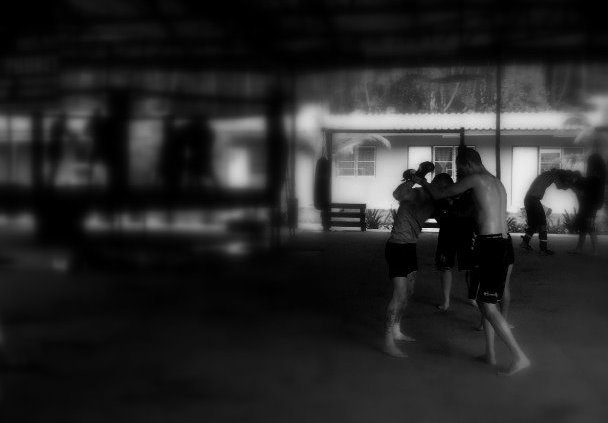
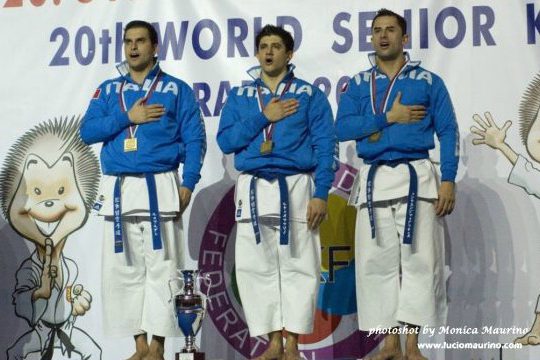

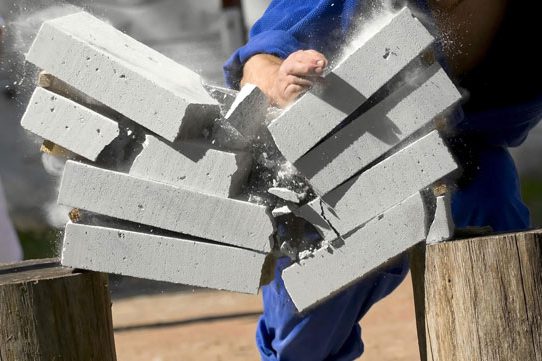
4 Comments